Forgotten War Group Build – Special Hobby 1/48 Fairey Firefly F.R.1, HMS Triumph, 1950
You can see the WIP for this model at the Forgotten War Group Build.
History:
The Fleet Air Arm was the only carrier air arm to carry on with the development and operation of the two-seat carrier fighter past the early 1930s. Both the Japanese and American naval air forces determined that the extra weight of the second crewman had too much negative effect on aircraft performance to justify the "safety" of over-water operations with a dedicated navigator- radioman aboard. As was shown during the Second World War, this was the right decision. The first result of this policy was the Fairey Fulmar, which bore the brunt of Fleet Air Arm fighter operations in the Mediterranean through 1940-41.
In July 1939, the Royal Navy put out a second requirement for a modern carrier-based fighter superior to the Fulmar, to be powered by the then new and untried Rolls-Royce Griffon. Specification N8/39 called for a Griffon-powered two-seater armed with 4 20mm cannon or eight .30-cal machine guns. Fairey responded with a design smaller than the Fulmar, armed with 20mm cannon, with an empty weight barely less than the Fulmar's loaded weight. By June 6, 1940, the mock-up had been inspected and approved, and specification N5/40 was written around the design. Thirteen months later, the first Firefly I, Z1826, flew on December 22, 1941.
The Firefly was the first to use the Fairey-patented area- increasing Youngman flaps, providing necessary maneuverability in combat, and lowering the landing speed of this heavy aircraft to be compatible with carrier operation. The first production aircraft was turned over to the FAA on March 4, 1943, a very respectable timetable for wartime aircraft development. This was fortunate, because every other British-designed carrier aircraft ordered in the same timeframe ran into development difficulties and failed to fly before the end of the war. Thus, the Fulmar would be the only really modern, high-performance carrier aircraft of British design to fly off British carriers in the war it was designed for.
Even with the 1,735 horsepower of the Griffon IIB, the Firefly lacked performance. Top speed was only 319 mph and climb rate under 2,000 fpm, though it had a useful range of 774 miles on internal fuel. The Firely became a strike and tactical recon aircraft, rather than the fleet defense fighter originally called for. It was more than capable of the mission, and the aircraft in its developed versions formed the backbone of the Royal Navy's aerial strike force through the end of the Korean War.
Interestingly, on all points save speed, a Firefly I sent to the US Navy test center at Patuxent River in 1944 more than held its own in air combat against the standard U.S. Navy carrier fighter, the F6F Hellcat - those Youngman flaps worked.
HMS Triumph Saves The Day in 1950:
On 25 June 1950, the North Korean invasion of South Korea found the United States in a greater state of military unpreparedness than had the Japanese attack on Pearl Harbor nine and a half years earlier. In the wake of the creation of the Department of Defense in 1948, a decision meant to unify the armed forces, the unification arguments of the preceding year, combined with President Truman's desire to cut military spending to levels not seen since before 1941, had the military service in disarray. President Truman's decision to intervene in Korea caught the U.S. Navy even more unprepared for combat in the Far East than the other services. In the years following the end of the Second World War, the Navy and Marine Corps had been drastically reduced. With the creation of the Air Force as an independent co-equal service, and the creation of the Department of Defense to unify the armed forces, there had been a series of political battles over the dominance of the Air Force as the prime delivery force of the U.S. nuclear arsenal. Following the cancellation of the new aircraft carrier USS United States in 1949, there had been a real fear that Naval Aviation would be transferred to the Air Force, while the Marine Corps was inducted into the Army.
The Navy was so reduced by budget constraints that before January 1950, no U.S. aircraft carrier had operated west of Hawaii since 1947. USS Boxer (CV-21) had deployed to the Far East on 11 January, returning to the United States on 13 June when she was relieved by USS Valley Forge (CV-47). Additionally, since there were no major operating facilities for naval ships in Japan, the Seventh Fleet was based at Subic Bay in the Philippines, distant from Korea. Fortunately, Air Group 5 aboard Valley force was the most modern naval air group, with two squadrons of F9F-2 Panthers, two squadrons of F4U-4B Corsairs, and a squadron of new AD-4 Skyraiders. E
The only other naval force in the Far East was the Royal Navy squadron at Hong Kong. The Royal Navy had been subject to even greater post-war economies than had the U.S. Navy. A single light carrier, HMS Triumph, had operated in the Far East since the preceding December and was preparing to return to Britain. Triumph's Carrier Air Wing 13 consisted of 800 Squadron's 12 obsolescent Seafire 47 fighters and 827 Squadron's 12 obsolete Firefly I light attack bombers.
Acting on his own on 26 June, Rear Admiral Sir William G. Andrewes, RN, commander of the Royal Navy's Far Eastern Fleet, departed Hong Kong at 0130 hours, directing his ships to concentrate in Southern Japanese ports. HMS Triumph was nearing Hong Kong after flying missions in support of Operation Firedog, the battle with communist guerillas in Malaya. The two formations met at sea, Triumph joining the heavy cruisers HMS Jamaica and Belfast, flying Admiral Andrewes' flag, destroyers Cossack and Consort, and frigates Black Swan, Alacrity, Hart and Shoalhaven, with the Australian HMAS Bataan. The Commonwealth fleet arrived at the Royal Australian Navy base in Kure, Japan, on 28 June. By 29 June, all Commonwealth forces in the Far East as well as Canada had been ordered to participate in the UN force. Task Force 77 (the official designation of the Seventh Fleet Striking Force)departed Subic Bay on 27 June, and arrived at Buckner Bay, Okinawa, on 30 June, where it was joined the next day by the Commonwealth fleet.
The morning of 29 June, four days after the outbreak of war, Republican Senator Robert Taft of Ohio, leader of the conservative, Midwestern, isolationist wing of the party, rose in the Senate and attacked the President for not seeking congressional approval to go to war, stating further that the North Korean invasion revealed the flaws of the Acheson foreign policy that had led to a policy that was “soft on communism” and called for Acheson's resignation. Later that afternoon, President Truman met reporters at Blair House and attempted to downplay events in Korea because he was intent on limiting any sense that there was a growing confrontation with the Soviet Union, as Republicans had been claiming. One reporter asked if the United States was actually at war, to which Truman replied it was not. A second reporter asked “Would it be possible to call this a police action under the United Nations?” “Yes,” the President answered. “That is exactly what it amounts to.” Out of a question casually asked and answered would a war and its policies be defined.
Following the press conference, Truman learned that North Korean forces were close to Seoul. General MacArthur called shortly thereafter and stated his belief that the situation could not be stabilized without the introduction of American ground combat forces.
At 0130 hours on the morning of 30 June, Ambassador Muccio notified Acheson that “things were desperate on the peninsula,” and that MacArthur was going to formally request the authority to commit ground troops. The General's cable to the Joint Chiefs arrived 90 minutes later. His words were fateful: “The only assurance for holding of the present line, and the ability to regain the lost ground, is through the introduction of U.S. ground forces into the Korean battle area. To continue to utilize the forces of our Air and Navy without an effective ground element cannot be decisive.”
With the President's approval, the 24th Infantry Division was ordered to establish a Regimental Combat Team for transfer to Korea. On 1 July, the two squadrons of B-29s in the Far East flew from Guam to Kadena Air Base on Okinawa, where they prepared to commence bombing operations in North Korea as soon as possible.
The combined fleet sortied from Okinawa on 1 July, with the British cruisers and frigates, now designated Task Group 96.8, the West Korean Support Group, departing to reinforce the American fire support group off the coast of South Korea. Task Force 77 was ordered to strike the North Korean capital of Pyongyang.
By dawn on 3 July, Task Force 77 had reached the middle of the Yellow Sea, 150 miles from their North Korean target, but only 100 miles from Chinese airfields on the Shantung Peninsula and less than 200 miles from the Soviet air base at Port Arthur. At 0500 hours, USS Valley Forge launched combat air and anti-submarine patrols. At 0545 hours, HMS Triumph launched nine Seafires and twelve Fireflies to attack the airfield at Haeju. At 0600 hours, Valley Forge launched sixteen Corsairs from VF-53 and VF-54, and twelve Skyraiders from VA-55 against Pyongyang airfield. When the propeller planes had gained a suitable head start, Valley Forge catapulted eight F9F 2 Panthers of VF-51 that would be the first aircraft over the target. When the American jets swept over the North Korean capital, two airborne Yak-9s were spotted and destroyed, with another damaged, while nine aircraft were reported destroyed on the ground by strafing attacks. The Corsairs and Skyraiders followed the Panthers, bombing hangars and fuel storage at Pyongyang airfield while the British force hit nearby Haeju. Anti-aircraft opposition was negligible, and the attackers suffered no damage or loss.
That afternoon, aircraft from Triumph flew a second strike against railroad lines, while Valley Forge launched a second strike against the rail marshaling yards in Pyongyang and the bridges over the Taedong River. Considerable damage was inflicted on locomotives and rolling stock, but the bridges survived. In view of the “rapidly deteriorating Korean situation,” as General MacArthur reported it, additional strikes were flown on 4 July, with further damage inflicted on railroads while one bridge over the Taedong was knocked down. Four Skyraiders were damaged in these final strikes.
The sudden appearance of U.S. and British aircraft more than 400 miles from the nearest American airfield was a rude awakening for the North Koreans. Indeed, the attacks may have deterred Stalin from making good on a sizable commitment of Soviet aircraft to support the North Korean Army that week, for which the North Koreans had been negotiating since the outbreak of war. In addition to deterring immediate Soviet participation in the war, the value of carrier striking forces had been proven once again and would never again be seriously questioned. The U.S. Navy had won the political argument over service integration; there would never again be any proposals to abolish naval aviation.
For the rest of the month of July, the Fireflies operated as spotter aircraft for the surface fleet gunfire support units as they attacked the North Korean transport system, while the short-ranged Seafires were used for air defense of the fleet. Following the stabilization of the front at the Pusan Perimeter, the British aircraft participated fully in support of UN ground forces in the desperate fight to hold off the North Korean Army.
Over the course of August and early September, all Firefly F.R.1 aircraft in the Far East were used up in operations, along with the nine Seafire 47s available for replacement. Half of 827 Squadron was now composed of World War II retreads scavenged from storage throughout British installations in the Far East, and only four could be launched at a time. When Triumph finally departed for the UK following the Inchon Invasion, only three of her aircraft were operational. Carrier Air Wing 13 had performed “above and beyond” in preventing catastrophe in the opening months of the Korean War.
The Kit:
Grand Phoenix released a 1/48 Firefly I around 2003, with AZ models releasing essentially the same kit following the demise of Grand Phoenix. Special Hobby released their Firefly in 2013 as part of a series that has eventually included the Firefly 4/5, the A.S.6 and the U.7 drone. The Firefly I came in several releases, including “The Early British Missions In Korea” release, which had decals for four different Fireflies operated by 827 Squadron, including PP433, a World War II retread in the FAA camouflage of that conflict.
Like the other Firefly kits in the series, the kit has a resin main gear well, with the cockpit in plastic and fairly thick clear plastic canopies. Surface detail is petite and restrained. The kit is one of the better Special Hobby limited releases, though it still needs putty and filler on all joints and seams.
CONSTRUCTION
It's a Special Hobby limited-run kit, with all that means. Lots of test fitting three times before gluing once, putty and filler over all joints and seams. However, the Special Hobby Firefly series (FR.1 FR. IV, FR. 5, AS.6-7) are very accurate (certainly far moreso than the collection of scrap plastic masquerading as “Fireflyish” released by Trumpeter which is wrong in so many ways there's not room here to list them all). This one was done with the Barracuda Studios vacuform canopies. These are advertised as fitting the Grand Phoenix and AZ kits, but they also fit the Special Hobby kits and really improve things.
I broke the construction process down to two major sub- assemblies, the fuselage and wing. Assembly of the fuselage began with assembly and finish of the cockpits. These were painted British Interior Green, which I did with Tamiya “Cockpit Green XF-71, with the rest of the “black boxes” done with Tamiy X-18 “Semi-gloss Black” highlighted detail with a silver pencil. I used the kit decal for the instrument panel. The seats were made of cellulose like Spitfire seats, so were painted Tamiya “Hull Red”. I used Eduard photoetch seatbelts. The fuselage was then assembled.
Assembly of the wing started with attaching the resin wheel well to the lower wing surface. I test fitted the entire wing and discovered this resin block would fit with only a bit of sanding-down fore and aft. I superglued it in position, then attached up upper wings. With careful fitting, the wing attached to the fuselage with a good join of upper wing to fuselage. I then attached the horizontal stabilizers. After allowing everything to set up overnight, I applied Mr. Surfacer to every joint and then sand down, re-apply, sand some more, then rescribe detail.
With careful trimming, the Barracuda vacuform windshield for the front cockpit and the canopy for the rear cockpit fit perfectly.
Camo and Markings:
Thinking I would make at least some use of the decals from the horrible Trumpeter kit, I decided to use the black/white ID stripe decals. After pre-shading the model, I gave it an overall Temperate Sea Scheme of Extra Dark Sea Grey using Tamiya “Dark Grey” XF-24, “Dark Slate Grey using a misture of Tamiya Khaki Drab XF-51 and Tamiya “RLM Grey” XF-22, mixed 3:1 respectively, and Tamiyas “sky” XF-21, mixed with Tamiya “Flat White” XF-2 in a 3:1 mixture.
When it came time to use the ID stripe decals, they folded like the proverbial cheap suit and then ripped when I tried to straighten them out. I then masked off the areas and painted first Flat White, masking it off, and then Flat Black XF-1. This ended up looking much better than the decals would have.
Having experience with the Special Hobby decals, I first airbrushed them with Micro Liquid Decal Film. I started with the underwing serials, since they had to be fitted around the wheel wells and were the most difficult part of the process. The national insignia decals turned out to be opaque over the stripes, as well as being a bit small, so I got proper-sized national insignia from my extensive collection of British WW2 insignia, and used the kit decals for the squadron number and carrier designator as well as the serials.
I assembled the rockets, painted the bodies flat black and the heads Bronze Green, and attached them to the lower wings. I then unmasked the canopies and glued the forward canopy on in the open position. Once cut free, there was some problem getting the vacuform canopy to sit down right, and if I were to do this again I would have the front office with a closed canopy like the rear.
Conclusions:
Special Hobby's Firefly series are the best kits of this important airplane available in 1/48. Stay well away from the Trumpeter kit, the product of their “F” (for “Failure”) Team. This is not a difficult kit for any modeler with a modicum of experience with limited-run kits and makes up into an attractive model.

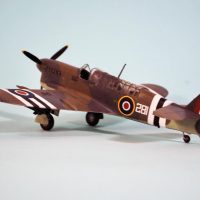
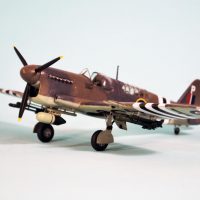
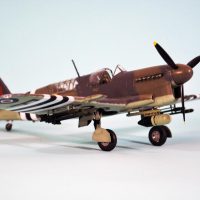
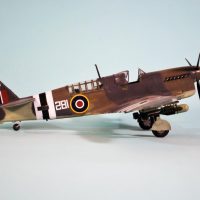


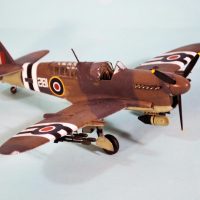

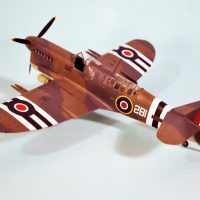

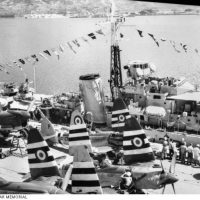
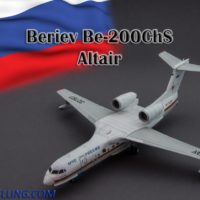

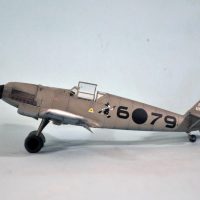
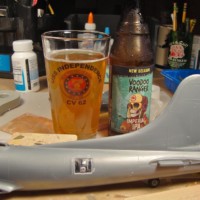
Very nicely done, Tom.
Thanks for sharing this great background information.
I do like that last posted picture, Fireflies really packed together.
Turned out great Tom. I never get tired of that kit. SH makes every variant of the Firefly that was produced.
Great build and history, Tom.
I have not been on here for a while - life has very much 'got in the way' of modelling this year. I had a look at the WIP - it is great that you are doing more builds here! Always fascinating to see 'the process'. The Korea/EoJ groups are better for it!
Great Firefly! I built the old 1/72 Airfix kit when I first jumped back into modeling, and have been wanting to add another to my stash for awhile - there's just something about it that is appealing to me. Following your lead to put her in Korean War livery would be a good excuse...
Nice build and interesting article ?
Congratulations, Tom @tcinla!
A beautiful Firefly out of a limited run kit (meaning: difficult, no matter how good the kit might be).
An equally excellent supporting historical background!
I don't have the Firefly in my stash, but what a temptation to get and build one!
Nice one Tom. I like it.
You make building it seem so easy, I know it's not, another great addition to this group, and definitely liked.
Nice model of an almost forgotten plane. Special Hobbies might be tough to build sometimes, but they really do try for accuracy. I don't know how Trumpeter can butcher these which should be impossible the era of CAD, but here we are.
Had similar problems with Special Hobby decals. The black ones seem to be really problematic.
Nicely done!
Excellent build and narrative Tom. Thanks for sharing the facts with us and the photos.